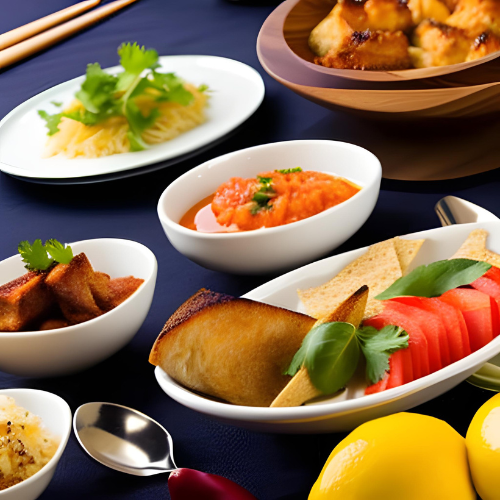When it comes to throwing a memorable food and beverage event, one secret ingredient can elevate your occasion from good to unforgettable: local cuisine. Showcasing the unique flavors and culinary heritage of your local area not only adds a dash of authenticity to your event but also creates an immersive experience that leaves a lasting impression on your guests’ palates. In this extensive guide, we’ll delve into 10 brilliant ways you can incorporate local cuisine into events, transforming your food and beverage soirée into a gastronomic adventure that celebrates regional diversity and sparks meaningful conversations around food. So, let’s set the table and start our journey.
Incorporate Local Ingredients in Your Menu:
Local ingredients are the bedrock of any regional cuisine. Sourcing ingredients from nearby farms and markets isn’t just a boon for your local economy, it also lends an incredible freshness and quality to your dishes. For starters, the shorter transport time ensures that your ingredients retain more of their natural flavors and nutrients, delivering a dining experience that’s as healthy as it is delicious.
But that’s just the tip of the iceberg. What makes local ingredients truly special is their ability to tell a story. Each locally sourced ingredient comes with its unique narrative of the land it was grown on, the people who cultivated it, and the traditional practices that brought it to your plate. By incorporating these ingredients into your menu, you’re not just serving food, but you’re also sharing these stories with your guests, creating a dining experience that’s rich in culture and context.
So, how can you weave local ingredients into your event menu?
Start by doing some research on your local food scene. Visit farmers’ markets, talk to local growers and food artisans, and find out what ingredients are in season during the time of your event. Seasonal produce is not only at its freshest, but it also carries the very essence of the time of year, adding an extra layer of depth to your dishes.
Once you’ve got a list of potential ingredients, work with your chef or catering team to create a menu that showcases these local stars. You could use a local cheese in your appetizer, serve a main dish featuring locally raised meat, or sweeten the deal with a dessert made from seasonal fruits. The key here is to let the ingredients shine, using cooking techniques that highlight their natural flavors and textures.
Remember, incorporating local ingredients in your event menu isn’t just about the food. It’s also an opportunity to educate your guests about the local food culture and the benefits of eating locally sourced-produce. Consider including a section in your menu or program that talks about the origins of each local ingredient, or even host a mini-presentation or cooking demonstration that dives deeper into the topic.
Incorporating local ingredients in your food and beverage event is the first step towards creating a memorable culinary experience that’s rooted in the flavors and stories of your local area. It’s a celebration of the community and the land, a chance to connect with our food on a deeper level, and a testament to the power of local cuisine in events.
Collaborate with Local Chefs and Food Artisans:
Another effective way to incorporate local cuisine into your event is by collaborating with local chefs and food artisans. These individuals are experts in their craft and have an intimate understanding of the local food scene. They’re not just culinary artists, but also storytellers who can bring the local cuisine to life with their skills and knowledge.
Firstly, consider hiring a local chef to curate and prepare the menu for your event. Local chefs can provide a distinct touch to the dishes with their knowledge of local ingredients, traditional cooking techniques, and regional flavors. Their culinary expertise, combined with their understanding of the local food culture, can create a unique and authentic dining experience that your guests will love.
A local chef’s involvement can go beyond just cooking. They can also serve as a spokesperson for the local cuisine, sharing interesting insights about the dishes being served, their cultural significance, and their preparation methods. This not only makes the dining experience more engaging but also educates guests about the local food culture.
Secondly, consider partnering with local food artisans. These could be local bakers, cheese makers, brewers, winemakers, or chocolatiers, among others. Their products can be featured in your menu, served as standalone offerings, or even be given away as event souvenirs. This not only adds variety to your food offerings but also supports local businesses.
Collaborating with local chefs and food artisans also offers an excellent opportunity for interactive activities. For instance, you can organize cooking demonstrations, tasting sessions, or workshops where these experts can share their craft with the attendees. This can add an element of fun and engagement to your event, making it more memorable.
By partnering with local chefs and food artisans, you’re not just showcasing local cuisine, you’re also promoting local talent and supporting the local food industry. It’s a win-win situation that enhances your event while contributing to your community.
Highlight Regional Dishes and Traditions:
No exploration of local cuisine would be complete without highlighting regional dishes and culinary traditions. These dishes are the heart and soul of any local cuisine, carrying with them centuries of history, culture, and tradition. By featuring regional dishes in your event, you’re inviting your guests on a culinary journey that takes them right to the heart of your local culture.
Start by identifying a few iconic dishes from your area. These could be anything from a beloved local snack, a traditional main course, or a signature dessert. The key is to pick dishes that truly represent the flavors and culinary techniques of your local cuisine.
Once you’ve selected your dishes, find ways to incorporate them into your event. They could be served as part of the main meal, as a unique appetizer, or as a special treat for your guests. Be sure to include a brief description of each dish, including its history, ingredients, and why it’s significant to your local area. This not only educates your guests about the dish but also enhances their dining experience.
But don’t just stop at the food. To truly bring these dishes to life, consider incorporating elements of the traditional dining experience as well. This could be anything from using traditional serving dishes and utensils, recreating a traditional table setting, or even following traditional dining customs and etiquette.
Featuring regional dishes and traditions in your food and beverage event does more than just satisfy your guests’ taste buds. It also provides them with a deeper understanding and appreciation of your local culture. It’s an experience that engages all the senses, creating memories that go beyond the dining table.
Create a Local Beverage Selection:
While food often takes center stage at events, beverages are just as crucial in creating an unforgettable culinary experience. And when it comes to showcasing local cuisine, your beverage selection is just as important as your food menu.
Local beverages can range from craft beers and wines to unique spirits, artisanal sodas, and even region-specific non-alcoholic drinks. Just like with local food, these beverages carry their own stories of local culture, tradition, and craftsmanship.
The first step in curating your local beverage menu is research. Find out what beverages are native to your region or are being produced locally. Visit local breweries, wineries, and distilleries, and talk to the owners and brewers. They can provide valuable insights into the beverage-making process and the unique aspects of their products.
Once you have an idea of the local beverages available, start curating a selection that complements your food menu. If you’re serving rich, hearty dishes, local craft beer or robust wine might be a good match. For lighter fare, an artisanal soda or local herbal tea might be more suitable.
Moreover, don’t forget to tell the stories behind these beverages. Just like with your food, you can provide information about the origins of each drink, the people who make them, and why they’re unique to your area. You could even invite local brewers, winemakers, or distillers to your event to talk about their craft.
Another excellent way to showcase local beverages is through tastings or pairing sessions. Guests can sample different drinks and learn how to pair them with specific foods. This not only makes your event more interactive but also educates your guests on the art of beverage pairing.
By incorporating a local beverage selection into your event, you’re enhancing your guests’ dining experience while promoting local beverage producers. It’s a delicious way to celebrate and support your local beverage scene.
Use Local Cuisine as a Theme for Your Event:
One impactful way to incorporate local cuisine into your food and beverage event is to make it the central theme of your occasion. By doing this, you’re not just serving local food and drinks; you’re creating an immersive experience that transports your guests into the heart of your local culture.
Turning local cuisine into a theme means more than just adjusting your menu. It’s about creating an environment that reflects the character and spirit of your local area. This can be achieved through the decor, music, activities, and even the attire of your staff.
Begin with setting the right ambiance. The decor should resonate with the local culture. This could mean using locally sourced flowers for the centerpieces, displaying artworks from local artists, or using traditional decorations. The aim is to create a setting that makes your guests feel like they’ve stepped into a different world, one that’s deeply connected to the local area.
Next, think about the music. Every region has its own unique soundtrack, whether it’s a specific music genre, local bands, or traditional folk music. Incorporating this into your event not only enhances the atmosphere but also serves as a tribute to the local music scene.
When it comes to activities, consider what would complement your local cuisine theme. This could be live cooking demonstrations from local chefs, traditional dance performances, or even interactive workshops like pottery or local craft making. These activities should be engaging, fun, and most importantly, they should echo the essence of your local culture.
Lastly, consider the attire of your event staff. Having them wear traditional clothing or colors associated with your local area can add a nice touch to your event. It’s a small detail, but one that can significantly enhance the authenticity of your theme.
Using local cuisine as a theme for your event requires careful planning and attention to detail, but the result can be a truly immersive experience. It’s a celebration of local culture that tantalizes all the senses, leaving your guests with memories that go beyond the taste of food.
Offer a Local Dessert Bar:
Who doesn’t love dessert? A dessert bar featuring local sweets and treats is a fantastic way to celebrate local cuisine at your food and beverage event. This not only offers a delightful end to the meal but also showcases the sweeter side of your local food culture.
Start by exploring the local dessert scene. What sweet treats is your area known for? These could be traditional pastries, artisanal chocolates, locally made ice creams, or even fresh fruits that are grown in the region. Remember, the aim is to highlight the diversity and uniqueness of your local dessert culture.
Once you’ve identified your selection of desserts, think about how you want to present them. A dessert bar allows you to get creative with the display. You could arrange the desserts on rustic wooden tables for a homely feel, or use glass stands and tiers for a more sophisticated look. The presentation should align with the overall theme and aesthetic of your event.
Also, consider offering a variety of portion sizes. Miniature versions of desserts can be a big hit, allowing guests to sample multiple treats without getting too full. You could also offer some desserts in full-size portions for those with a bigger sweet tooth.
Don’t forget to provide information about each dessert. This could include the ingredients, the story behind the dessert, or why it’s special to your local area. You could even invite the local bakers or dessert makers to talk about their creations. This adds an educational aspect to the dessert bar and allows your guests to appreciate the desserts on a deeper level.
A local dessert bar is more than just a treat for the taste buds. It’s a celebration of local confectionery skills and traditions, an exploration of local flavors, and a sweet ending to your event that leaves a lasting impression.
Encourage Local Dining Experiences:
Promoting local dining experiences is another innovative way to incorporate local cuisine into your food and beverage event. This is more about extending the culinary journey beyond your event and encouraging guests to explore the local food scene on their own.
One way to do this is by providing a local dining guide as part of your event program or as a takeaway. This guide could include a list of recommended local restaurants, cafes, and food markets, along with their addresses and contact details. You could also highlight specific dishes or experiences that your guests should try at each location.
Another idea is to offer “dining vouchers” or “experience coupons” for local eateries as part of your event. These could be given as prizes for games, included in gift bags, or even auctioned off in a charity event. This not only promotes local businesses but also gives your guests a reason to explore the local dining scene.
You could also invite local restaurants or food stalls to set up shop at your event. This gives your guests the opportunity to sample a variety of local dishes in one place. It’s also a great way to support local businesses and create a vibrant, festival-like atmosphere at your event.
Lastly, consider partnering with local food tours or culinary classes. These experiences offer a deeper dive into the local food culture and can be a unique addition to your event. You could offer these experiences as part of your event package or as optional add-ons for interested guests.
Encouraging local dining experiences at your food and beverage event helps create a stronger connection between your guests and the local food scene. It’s a way of extending the culinary journey and leaving a lasting impact long after the event is over.
Showcase Local Food Producers and Farmers:
An integral part of local cuisine is the people who produce the food – the farmers, fishermen, gardeners, and food producers. Showcasing these individuals and their products at your event can provide a deeper appreciation for the local cuisine and foster a stronger connection between your guests and the food they consume.
Start by sourcing ingredients directly from local farmers and producers for your event. This not only ensures fresh, quality ingredients for your dishes but also supports local agriculture. Moreover, sharing where the food comes from can be an interesting conversation starter and an educational aspect for your guests.
But don’t just stop at sourcing ingredients. Consider inviting local farmers and producers to your event. They can set up stalls to display and sell their products, or they can participate in talks or demonstrations to share their farming practices and the effort that goes into producing their goods.
Another idea is to organize a farmer’s market as part of your event. This can be a vibrant and interactive addition to your event where guests can browse and buy local produce, artisanal goods, and homemade treats. It’s a great way to support local businesses and create a community-focused atmosphere at your event.
You can also showcase local food producers and farmers through storytelling. This could be in the form of short documentaries or photo exhibits displayed at your event, telling the stories of these individuals and their dedication to their craft. It’s a powerful way to humanize the food we eat and show appreciation for the hard work that goes into producing it.
By showcasing local food producers and farmers at your food and beverage event, you’re not just celebrating local cuisine; you’re honoring the people behind it. It’s a powerful way to create a sense of community and promote sustainable dining practices.
Plan a Farm-to-Table Experience:
A farm-to-table experience takes the concept of local cuisine to another level. This approach emphasizes using fresh, locally sourced ingredients and highlights the journey of food from the farm to the dining table. Planning such an experience for your event can be a unique and impactful way to celebrate local cuisine.
First, consider the venue. A farm-to-table event is often hosted outdoors, ideally on a farm or a garden setting. This creates a natural, rustic ambiance and allows guests to be closer to the source of their food. If this isn’t feasible, an indoor venue can be decorated to mimic a farm-like setting.
The menu should be curated based on what’s in season and locally available. This might require you to work closely with local farmers and producers to understand what products will be available at the time of your event. The dishes should highlight the natural flavors of the ingredients, allowing their freshness and quality to shine through.
In addition to the food, consider incorporating other elements that celebrate local agriculture. This could be floral arrangements made from locally grown flowers, table runners made from burlap or other natural materials, or even centerpieces featuring local fruits and vegetables.
Furthermore, consider offering a tour of the farm or a demonstration of how the food is harvested as part of the event. This provides an educational aspect and allows guests to appreciate the effort that goes into producing the food they eat.
You can also invite a local farmer or producer to speak at your event. They can share insights about sustainable farming practices, the challenges they face, and why supporting local agriculture is important.
Planning a farm-to-table experience requires careful planning and coordination, but the result can be a memorable and impactful event. It’s a celebration of local agriculture and a testament to the freshness, quality, and sustainability of local cuisine.
Collaborate with Local Chefs and Culinary Experts:
The final point in incorporating local cuisine into your food and beverage event involves collaboration with local chefs and culinary experts. These individuals have a deep understanding of the local food scene, and their expertise can add authenticity and depth to your event.
Local chefs can bring their unique perspectives and culinary skills to your event, whether it’s through cooking demonstrations, food presentations, or by curating a special menu. Their involvement not only adds credibility to your event but also provides a platform for them to showcase their talent.
But it’s not just about chefs. Culinary experts, such as food historians, cookbook authors, or culinary instructors, can also provide valuable contributions to your event. They can share insights about the history of local cuisine, demonstrate cooking techniques, or talk about the cultural significance of certain dishes.
Consider holding a panel discussion or a Q&A session with these culinary experts. This allows your guests to interact with them, ask questions, and learn more about the local food culture. This interaction can make your event more engaging and educational.
Another idea is to host cooking workshops or masterclasses led by these chefs or culinary experts. Guests can learn how to cook a local dish, mix a local drink, or even learn about food presentation and plating. This makes your event interactive and provides a unique experience for your guests.
Collaborating with local chefs and culinary experts does more than just add value to your event. It also builds a sense of community and promotes the sharing of knowledge and skills. It’s a celebration of culinary talent and a tribute to the people who shape and define the local food scene.
And that concludes our exploration of “How to Incorporate Local Cuisine into a Food and Beverage Event.” Remember, celebrating local cuisine is not just about the food; it’s about the people, the culture, and the traditions that create a unique culinary identity. It’s a culinary journey that leaves a lasting impression and creates a deeper connection between guests and the local area. Enjoy your event planning and bon appétit!
We welcome any suggestions or questions. You can email us or contact us using the contact page.
You can also connect with us on the following social networks:









0 Comments